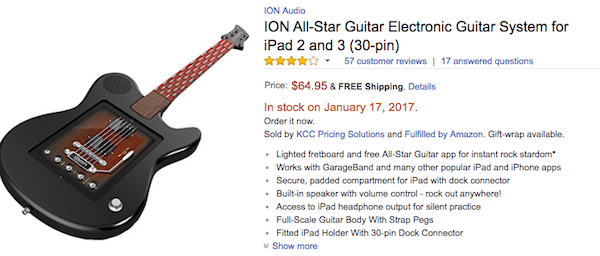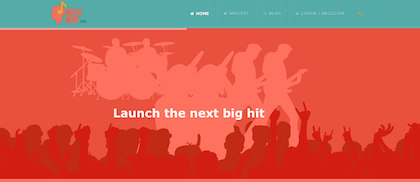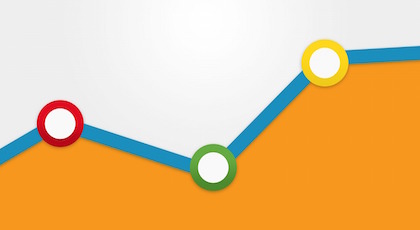After you’ve successfully raised money on Kickstarter, there are a few different ways that you can continue to get sales. The Kickstarter collection on Amazon Launchpad is an awesome way to continue to make money from your product and grow the audience around your product.
At the time of writing, all that you have to do is apply to the service by filling out a short questionnaire. You’ll need to answer questions like your:
- Company name
- Product name
- Contact information
- Product funding sources
- Shipping status
- and more.
Once you’re accepted into the Launchpad marketplace, then the fun begins! This blog post will share a few ways that you can make the most of your time there. I’ll help you get more sales and build a brand online.
1. Master Amazon SEO With Keyword Research
I know that you have a name for your product and your company. That doesn’t mean that you can’t use your product description or Amazon product name as an opportunity to rank better in the overall marketplace.
Of course, you shouldn’t be inauthentic or manipulative, but it makes sense to describe your product using similar language as your customer base. You need to pinpoint what they’d type into the Amazon search bar in order to find your product.
 In order to break down how to do this, I’m going to use the Jamstik+ as an example. I had the founding team on episode #31 of my podcast. They raised $813,803 on Kickstarter and a #1 Best Seller in “Recording Virtual Instruments Software.“
In order to break down how to do this, I’m going to use the Jamstik+ as an example. I had the founding team on episode #31 of my podcast. They raised $813,803 on Kickstarter and a #1 Best Seller in “Recording Virtual Instruments Software.“
They’ve also received 166 customer reviews, the majority of which are 4 star or higher.
The first thing that I’m going to do is look at the title that they used in Amazon. This complete title is, “Jamstik+ Black Portable App Enabled MIDI Electric Guitar, for Beginners and Music Creators, iOS, Android & Mac Compatible, with Bluetooth Connectivity, Powered by Zivix.”
Pretty lengthy title, eh? Although it might seem harder on the eyes, it actually enables them to rank for a lot more key terms. For instance, if I type in “electric guitar for beginners,” their product pops up in the Amazon search engine.
Woah!? Cool, huh?
You can use the title of your product to influence which searches your product will end up in. You can also use the description of your product to rank for keywords. According to Moz and Seller Central,
“Search is the primary way that customers use to locate products on Amazon.com. Customers search by entering keywords, which are matched against the search terms you enter for a product. Well-chosen search terms increase a product’s visibility and sales. The number of views for a product detail page can increase significantly by adding just one additional search term – if it’s a relevant and compelling term.”
The Jamstick+ has very short bullet points to highlight the various benefits of this guitar. I’ll go into your sales page next. For now, just notice they keywords they use.
I would recommend optimizing for keywords as much as possible, but don’t engage in any keyword stuffing. You never know how Amazon’s search algorithm fully works. The title of your product images might even factor in.
Naturally you’re going to need to do a bit of research to find out the RIGHT keywords for your category. You need to find out what words your customers are typing in when they have a particular problem or pain point.
2. Create an Appealing Sales Page
If there’s one thing that is going to affect how well you rank in Amazon, it’s your sales and conversions. Your Amazon page shouldn’t just be a simple directory page listing your product. You should take full advantaged of the space offered to SELL your product to the website visitor.
The fastest way to boost your sales is to increase your conversions. Let’s say you have a very simple product page. You list the product and what it does. 100 people come to your product page and 2 end up becoming buyers.
Now, you could either make more sales by sending MORE people to that page, or you could improve the conversion rate of that page so that MORE people that happen upon that page end up buying.
In this way, if 100 people came to the page, maybe 5 would end up becoming buyers. This is more than 2x the number of sales you were getting previously. It’s easier to improve your conversions to generate more sales than to DOUBLE the traffic to that page.
So, how could you enhance the buying experience?
Let’s take a look at the Jamstick+ sales page. The first thing that you’ll see are HIGHLY engaging images that show people using the product.
The model in the image makes me see myself playing the guitar, and brings the thought to mind, “if she can do it, I can do it!”
It’s also no secret that one of the reasons men learn the guitar is to appeal to females. This image brings that thought back to my mind. If I was a girl, I’d likely imagine myself playing the guitar, because I see another playing it.
The clear call to actions are that you can learn to play quickly and easily. You can also bring the guitar anywhere, rather than keeping it in your room. As you’ll see below, every bit of the marketing reinforces this message.
Immediately, you can see the initial benefits reinforced. You don’t need music experience to begin learning. You don’t need to do any tuning. You’ll be taught how to play with the app. It’s not hard to use this product. But, don’t worry, the strings feel real.
As you can see, this messaging is actually first CONVINCING the buyer that they can actually learn how to play guitar. Then, it’s convincing them that this product is the best solution for them.
Finally, you have the young female who’s enjoying her experience with the Jamstik+. It primes your mind to think that by buying this product, you’re going to get a lot of enjoyment out of the experience.
Again, these images make you feel like you can use the product. By having models in the images, it creates mental pictures in your head as to how YOU could use the product. You could use it in the car, on the airplane, etc.
In addition to including images in your sales page, you can also include video! Video is an extremely powerful way to connect with your customers.
When someone watches a video, they are much more emotionally engaged in the information. Rather than forming pictures in their brain after reading words, the video screen is forming the pictures for them. Then, in the future, they can recall those images or scenes that they saw.
It might seem odd, but the majority of this content is there to first show the customer that they can learn how to play guitar in a matter of minutes. It’s not going to take years. The company is first making the customer aware of their own abilities and “pumping them up.” You can see this in the message below.
Both of these messages continue to underscore how EASY it is to learn how to play using this product and that yes, in fact, you can do it. No matter what you’ve tried before, this product is different. It’s different because of x, y, and z. A lot of the images also help you imagine yourself playing guitar in the future and how happy you’ll be when you can FINALLy do that.
There is a lot more that we could discuss about their sales page, but I’ll leave that up to you to check out. The final thing that I’ll mention is how the actual logical technical specs of the product come at the end, not the beginning.
Of course, the details matter, but they aren’t what’s most important in a sales page. The most important thing is that you get “buy in” from the customer. The customer has to:
- Identify the problem they have.
- Believe that they can actually overcome it.
- Believe that YOUR solution will get them that result.
- Be happy about how they view themselves after that problem is solved.
This isn’t the end of the process though. Your product actually has to do what you say it will. If it doesn’t, you’ll get lots of angry reviews, which is what I’m going to cover next.
3. Use Reviews as Social Proof, Feedback, and Copywriting Material
Amazon reviews are the first thing that someone sees when they come to your product. They can’t quickly decide whether or not to take the time looking at your product. After all, why would anyone look at a product with bad reviews?
Reviews are a form of social proof. If other people say that a product is good, we are more likely to check it out ourselves. It’s a very simply way to get your foot in the door. You should make reviews one of your top priorities when you first launch on Amazon.
I’m not going to go through how to get reviews, though you can always reach out to me if you’d like me to review one of your startup products.
Instead, I want to touch on using reviews as a way to craft your sales page. Let’s take a look at a competing iPad compatible electric guitar product, the ION All-Star Guitar Electronic Guitar System. Now, I don’t mean to pick on this product. Actually, they seem like they have a cool thing going. I’m just using this example to illustrate how to use Amazon reviews to your advantage.
When I look at the 3 start and lower reviews, a few commonalities come up. I’ll list a few reviews below.
“It’s plastic, and is more for kids. It is probably me, but I can’t figure out how to change the orientation. “Strings” are upside down. For the price it is ok tho”
“It’s just a goofy toy. The response time is very lagging and only moderately recreates the real guitar experience. You certainly could not use this with a band or any serious performance. People like it when you wiggle the string however. Beyond that one chuckle, it’s pretty useless.”
“It would have been more impressive if there was real teaching content like chords and scales. I sent it back.”
“i realize that its only ~$33 but this is junk! My expectations weren’t high but this is just a waste of time and money! I returned mine about an hour after getting it!”
These are some pretty harsh reviews. Keep in mind that the product also has some very positive reviews.
There are a few big commonalities among these reviews:
- Viewing the product as a toy or for kids.
- Not enough teaching functionality to learn complex chords.
- Not enough value for the price point.
You can use reviews to inform your own marketing. You could address these concerns with your own sales page, or highlight these benefits, like “Use the app to learn quickly, and once you master that, learn complex cords!” Having photos with adults using the product also highlights the fact that the product isn’t just for kids.
You can also look at your product’s own negative reviews and address concerns or hint at future improvements that will be made to the product. The Jamstik+ also has a bunch of negative reviews that highlights how the product needs to make the product better.
4. Track Related Purchases
As an entrepreneur you should always be thinking, “How can I add more value to my customers?”
By looking at the products that are related to yours, you can begin to come up with a few ways to continue to grow your e-commerce sales by coming up with new product ideas.
For example, just looking at related products, I’ll see three three possible product ideas.
As you can see, people who bought the Jamstik also bought Guitar Picks, pick holders, and a music theory educational tool. You could consider looking into the patents around these products to see if you could offer anything similar in the future to your customers, or as a product bundle.
Grow Your Sales AND Audience
Putting your product in a public marketplace like Amazon will help you boost your sales and grow your audience. More people will find out about your product than if you were just simply to sell it on your own website using one of these ecommerce store builders.
If you want to continue to get more sales on your own website, I’d recommend looking into my video series which talks about various ways to boost your ecommerce sales. Enjoy!
















